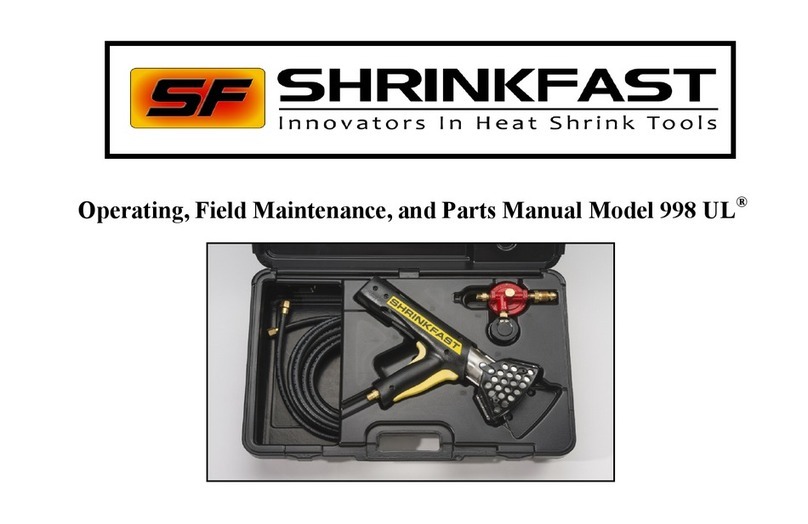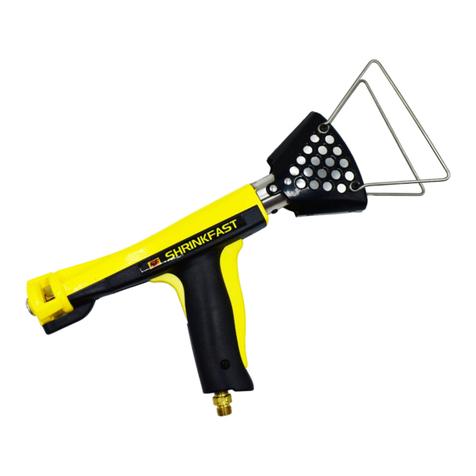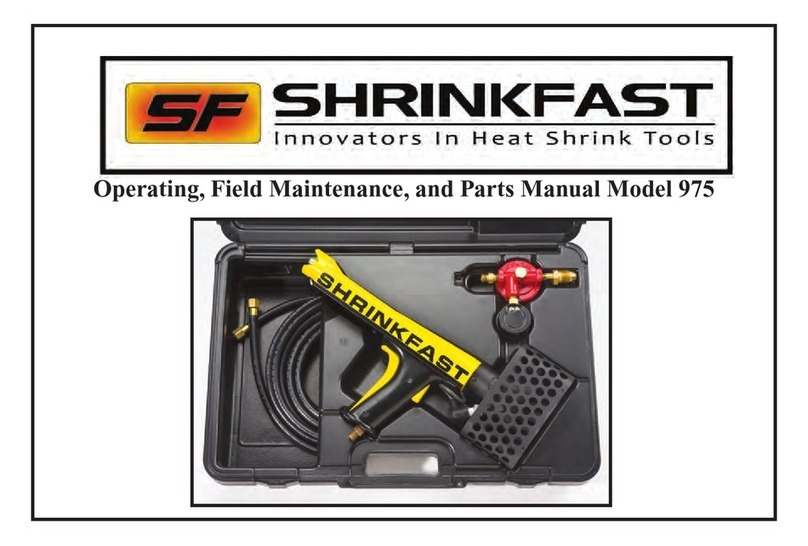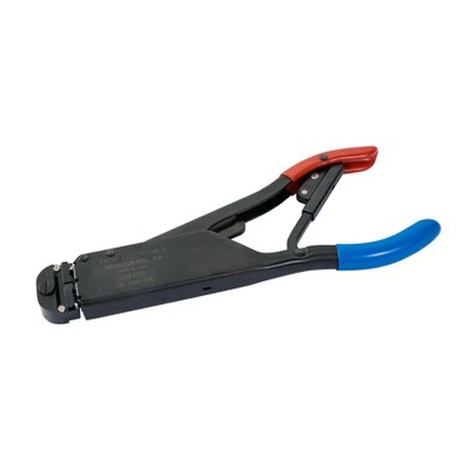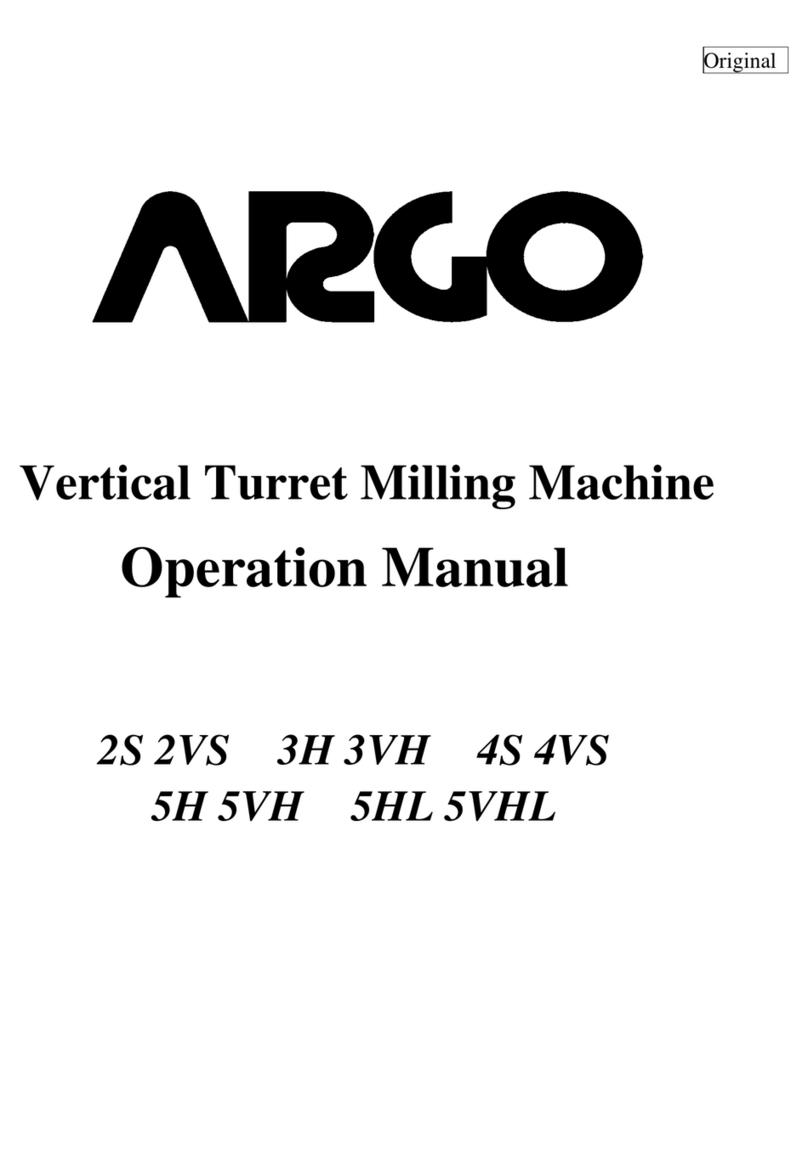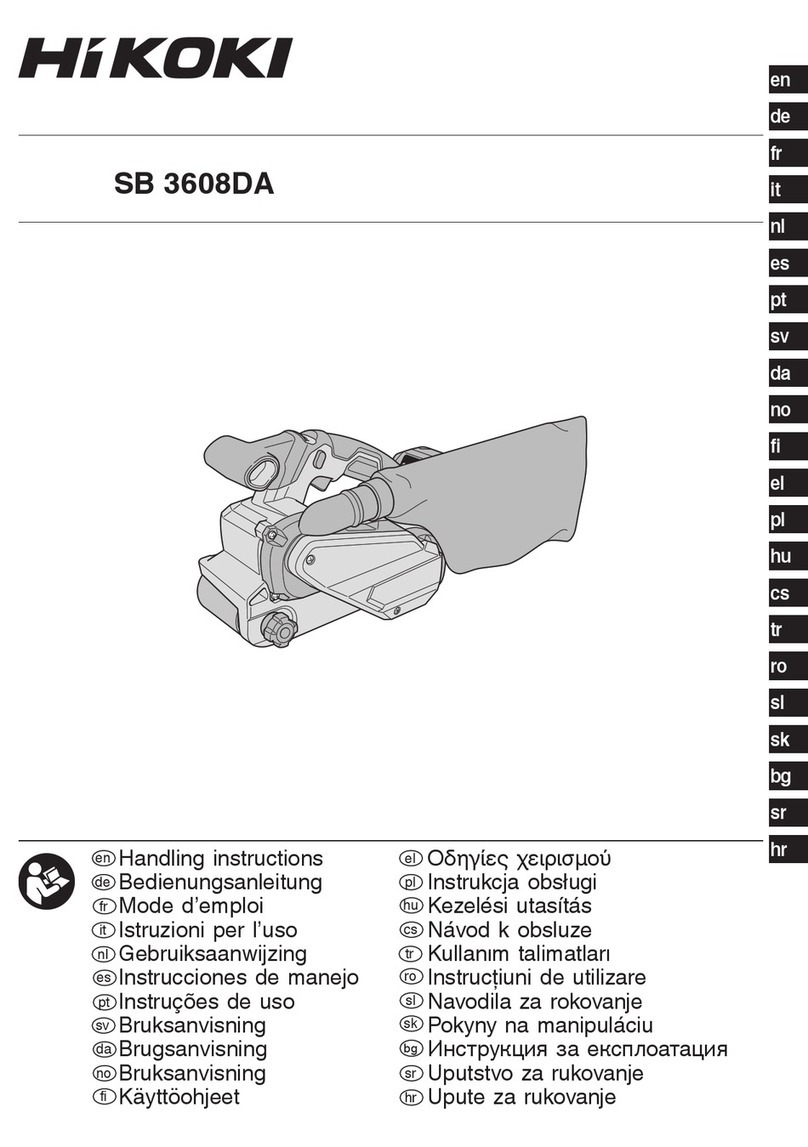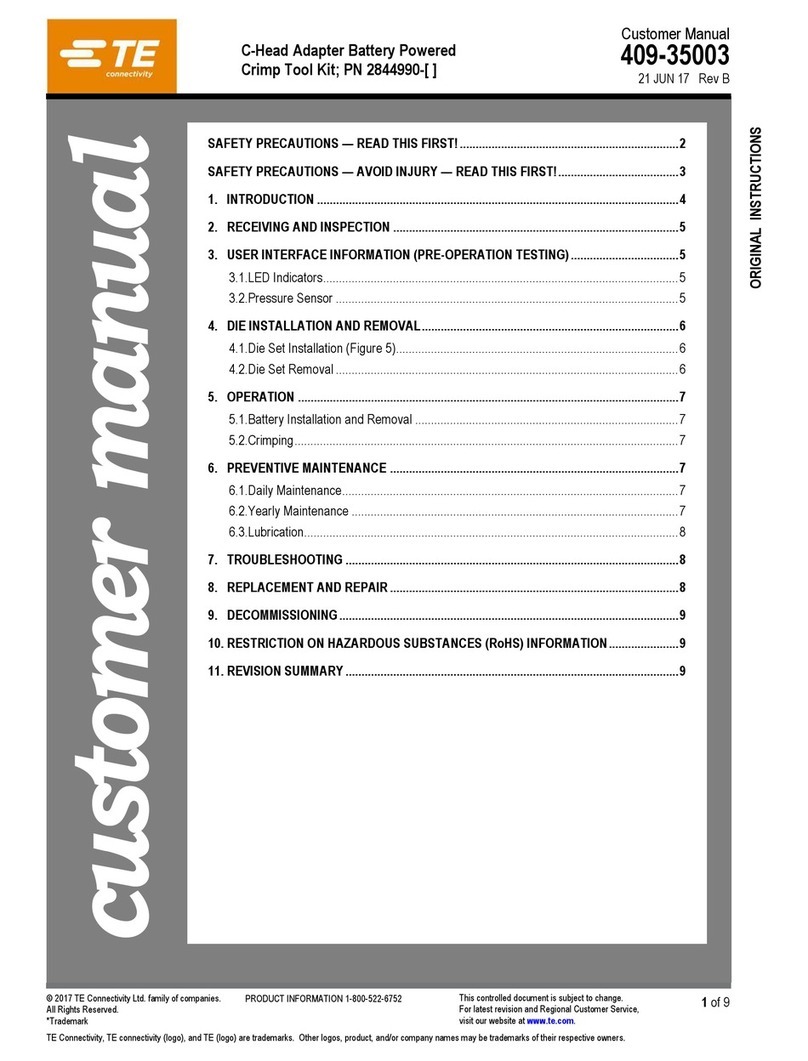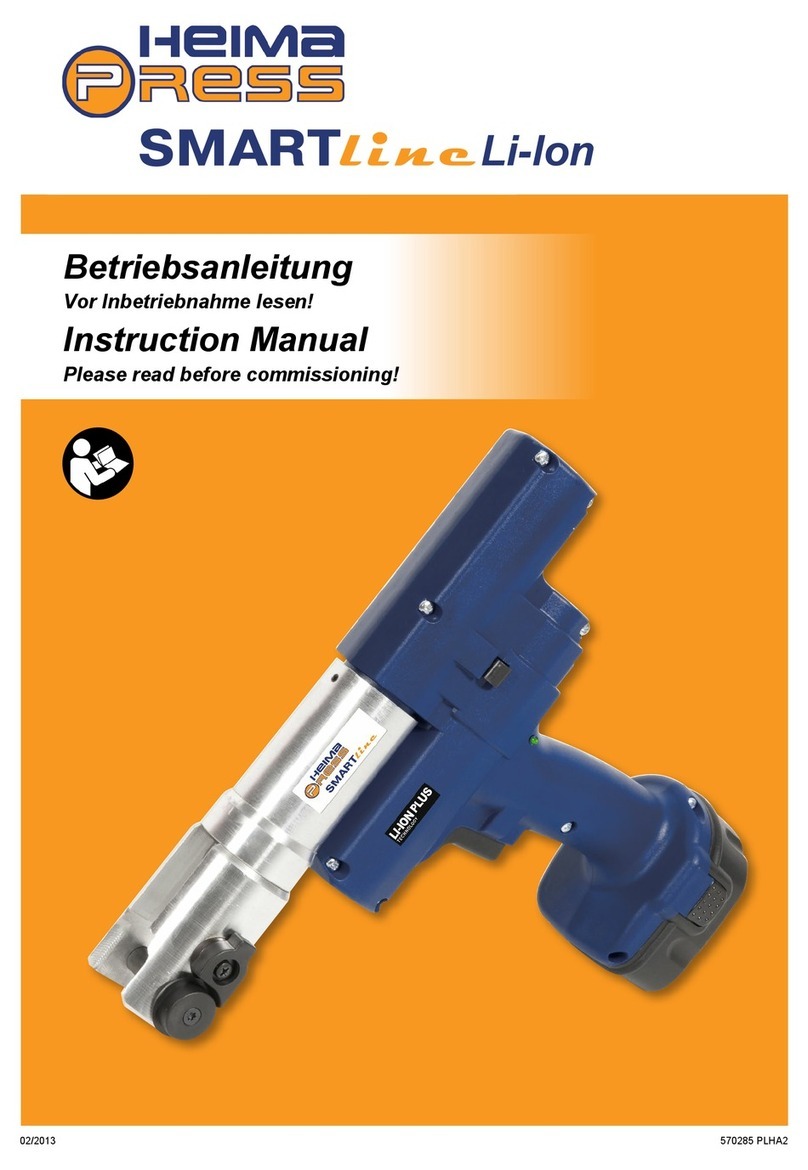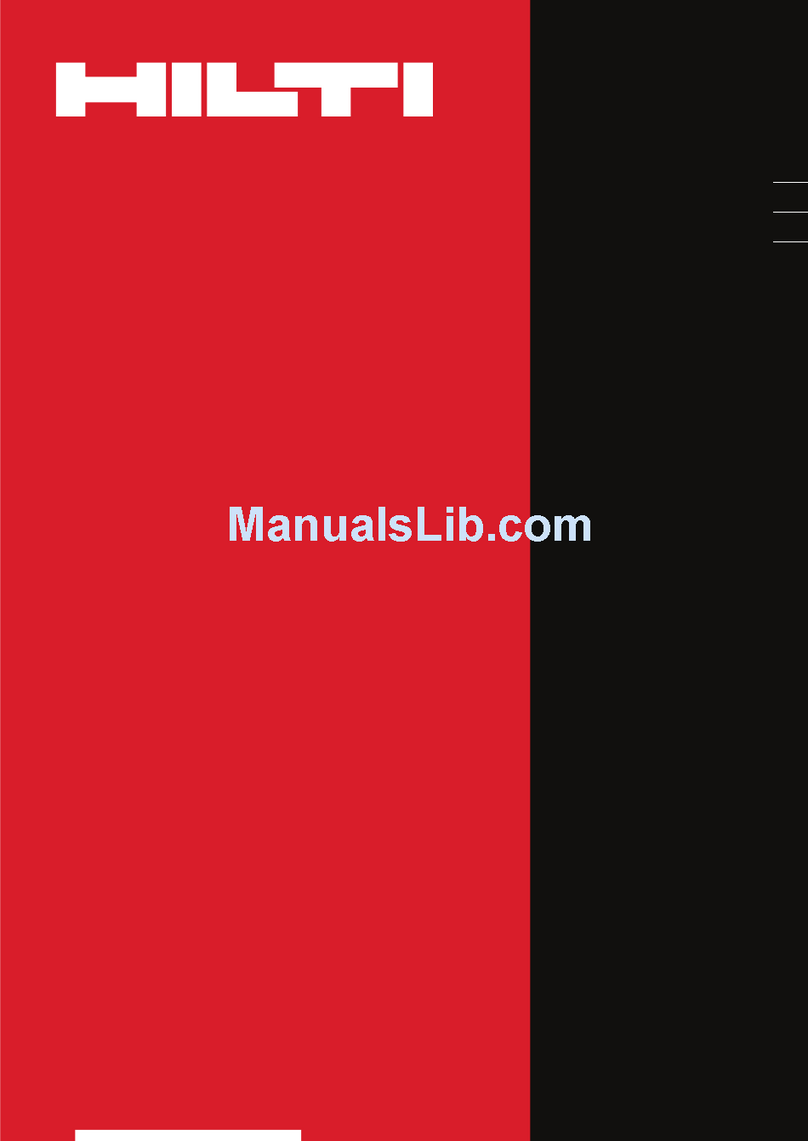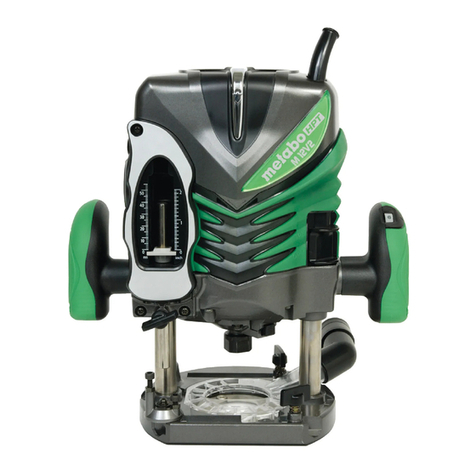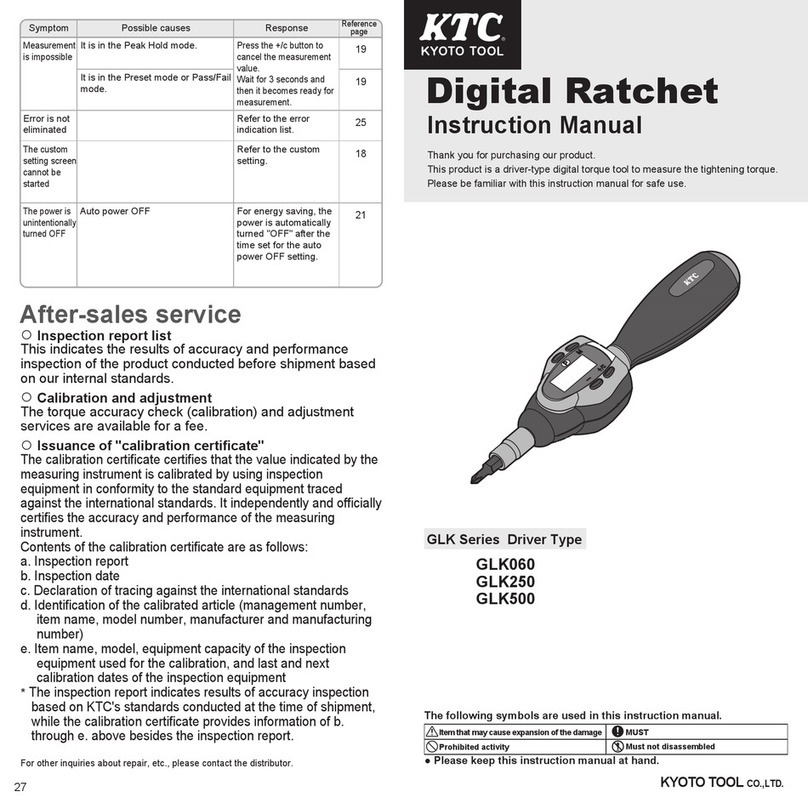Shrinkfast 998 User manual

Operating, Field Maintenance,
and Parts Manual
Model
998

General Safety Precautions
Never point the gun at anyone.
Inspect hose before each use for breaks or weakened spots.
Always shut off valve at tank when leaving the gun unattended for any length of time.
WARNING: DO NOT TOUCH WIRE METAL SHIELD AFTER GUN HAS BEEN FIRED.

Table Of Contents
I. Introduction
II. Which Bag To Buy
III. Which Tank To Use
IV. Ventilation Requirements
V. Operating Instructions
A. Controls
B. Connections
C.Start-up
D.How To Shrink
1. Pallets
2. Patching
3. Large Goods
VI.Service Information
A. Principles Of Operation
B. Troubleshooting
C.Assembly and Disassembly
D.Technical Specifications
E. Parts Breakdown & Spare Parts
I. Introduction
The New SHRINKFAST Model 998 heat
shrink tool has evolved from the previous
models 975 and 305X. The major new fea-
tures include cool combustor, lightweight,
durable and safety/trigger mechanism that
automatically shuts off if it should be
dropped. The simple design allows for field
repairs to be completed quickly and effi-
ciently.
The manual has also evolved into a simpli-
fied format which, if read carefully, will
greatly enhance the operator’s skill in using
the tool. In addition, every operator should
be particularly aware of the safety require-
ments covered in Section III WHICH TANK
TO USE and in Section IV VENTILATION
REQUIREMENTS.

II. Which Bag To Buy
Bag makers can usually be found in the
Yellow Pages under Packaging Supply
Houses or Bags – Transparent. Salesmen
are generally knowledgeable and can give
you good advice, but you should keep the
following facts in mind:
1. Not all plastic bags are shrink bags;
therefore, be specific. Shrink film should
always be made of virgin plastic, not
reprocessed material.
2. Bags come in various thicknesses. The
bag thickness is measured in mils. The most
common is 5 mil. For light loads such as a
load of cookies at 100 lbs./pallet, a 3 mil
bag should be satisfactory. However, drums
of molasses, for example, at 2000 lbs./pal-
let would require 6 mils or more.
3. Bags are made in two styles, centerfold
and gussetted. Gussetted bags shrink equal-
ly in both directions (35%/45%) and are trou-
blesome because they tend to pull up and
away from the pallet. Therefore, they should
be bought longer than the pallet height, and
special care should be taken in the bottom
shrink. Centerfold bags shrink mostly in one
direction around the pallet (60%/10%);
therefore, they don’t have a tendency to pull
up off the pallet.
4. Bag dimensions are specified by the
lay-flat length and width. Example:

To calculate the width, add:
1. The two sides 30”
47”
77”
2. Fitting allowance 4”
WIDTH 81”
To calculate the length, add:
1. 1/2 of the short side 15”
2. The height 36”
3. Shrink allowance –
1” for each foot of height 3”
LENGTH 54”
In this case the bag size is 81” x 54”.

III. Which Tank To Use
Two types of tanks are commonly available:
liquid withdrawal and vapor withdrawal. It is
crucial to use the vapor withdrawal type.
Never try to run the gun on a liquid with-
drawal tank.
Using a liquid withdrawal tank will clog the
orifice filter and may result in an extremely
dangerous long flame.
Tanks are available in 6, 8, 10, 20, 30, and
40 lb. Sizes. The gun will run on a 6 lb.
Tank if used only intermittently. Larger tanks
should be chosen for continuous use.
Tank pressure depends on the temperature
of the tank. At room temperature (72°F) the
pressure is 110 PSI and drops to 22 PSI at
0°F.
When in use, the temperature of the tank
drops due to the evaporation process of liq-
uid propane to propane gas.
After prolonged use the temperature of the
tank may drop to 0°F usually accompanied
by icing on the outside, and the propane
pressure drops below 15 PSI. DO NOT RUN
THE GUN WITH THE PRESSURE BELOW 15
PSI.
Small or nearly empty tanks ice up faster
than large, full tanks. Typically, a full 30 lb.
Tank , if run continuously, will run 90 min-
utes before it ices up. If the production
rates demand continuous use, the following
methods may be employed:
1. Multiple tanks. Switch the gun from one
tank to another.
2. Fan. An ordinary desk Fan fan at the
tank. The air flow around the tank will keep
it from icing up.


IV. Ventilation Requirements
In operation, the gun consumes propane
and air and produces carbon dioxide, car-
bon monoxide, and water vapor.
Prolonged exposure to carbon monoxide is
lethal and adequate ventilation must be pro-
vided if the gun is to be operated indoors.
The graph (right) shows measurements of
the amount of CO generated (expressed as
a percentage of the fresh air consumption
of 20 cu. Ft./min.) as a function of flame
adjustment:
The amount of CO generated depends on
the flame adjustment, but does not exceed
0.25% within the limits of very rich and very
lean. (By way of comparison, a 35HP forklift
truck running on propane generated 6 times
as much CO).
To maintain a safe CO concentration of 50
parts per million (OSHA standards
1910.93), the ventilation requirements are
2000 cu.ft./min. while the gun is operated
at the maximum operating pressure of 30
PSI.
Based on a 1 1/2 minute heating cycle per
pallet, the fresh air requirements are 3000
cu.ft./pallet. For a production rate of 10 pal-
lets/hour, a ventilation system with a contin-
uous capacity of 500 cu.ft./min. is ade-
quate. For different production rates, the
ventilation capacity should be sized propor-
tionally.
In areas where ventilation is provided by
open doors or windows, a safe level of CO
will be maintained as long as the room tem-
perature does not rise above 150°F.

V. Operating Instructions

A. Controls
No. Part Function
1Safety Trigger Prevents accidental gas release
2Gas Handle Actuates gas valve and igniter
3. Gas Valve Open fuel flow
4. Igniter Fires piezoelectric spark igniter
5. Fuel line Carries fuel to orifice
6. Filter Prevents clogging
7. Orifice Meters fuel
8. Spark Plug Ignites mixture
9. Flame Holder Prevents flashback and flame out
10. Hose Connects regulator and gun
11. Regulator Regulates pressure to gun
12. Adjustment screw Sets pressure
13. Pressure Gauge Indicates pressure in the line
14. Pol Fitting Connects and contains excess flow check valve
15. Tank See section on tank
16. Tank Valve Opens/closes fuel supply
For ordering of spare parts, see page XX and XX.

B. Connections
Connect the gun, hose and regulator to the
tank using a wrench to tighten the fittings
which all have left hand threads.
To check for leaks, open the tank valve with-
out actuating the gun handle to pressurize
the hose. The pressure gauge should read
between 15 and 30 PSI when the gun is not
in use. Then close the tank valve and
observe the pressure gauge. A rapid loss of
pressure indicates a leak. Check all connec-
tions.
C. Start-Up
After all connections are made and checked
for leaks, the gun is ready for use. Open the
tank valve. Wait approximately 5 seconds to
fully pressurize the hose or until the excess
flow check valve opens with an audible click.
To start the gun, first press the safety trig-
ger which prevents the gas handle from
being accidentally opened. Then squeeze
the gas handle slowly all the way until the
igniter fires with an audible click. CAUTION,
GUN WILL IGNITE.
NOTES:
1. It is important to squeeze the gas han-
dle slowly. If the gas handle is squeezed too
quickly, the igniter will fire the spark plug
before the gas mixture gets there.
2. Should the gun fail to fire fully, release
both safety trigger and gas handle fully to
assure that the igniter is reset and repeat
the starting procedure.
3. The 998 heat tool comes complete with
a variable regulator assembly. The tool will
operate properly between 15 and 30 PSI.
For thinner films, we recommend the setting
to be on the low pressure side and adjust up
to the 30 PSI level as the films get thicker.
The factory setting is preset at 22 PSI.

D. How to Shrink
1. Palletizing
Your SHRINKFAST gun consumes oxygen
and must be used only in well ventilated
areas.
WARNING: DO NOT OPERATE GUN IN
AREAS WITH FLAMMABLE GASES OR
WHERE SMOKING IS
PROHIBITED.
a. Elevate the pallet load approximately 6
inches from the floor, leaving the under
sides of the four corners unobstructed.
b. Fit the pallet bag over the load, taking
care that the film is not punctured as it is
pulled into place. The bag should fit snugly
over the goods and overhand the base of
the pallet almost to the floor.
c. To bottom shrink, ignite the gun and
hold it approximately 12” from the film sur
face. Move once around the pallet apply
-ing heat to the bottom edge of the bag
and using the air velocity to blow it under
the pallet. Shrink it so that it grasps the
underside of the pallet firmly. In so doing,
the bag is locked to the pallet, thereby uni-
tizing the load.
d. To side shrink, do one side after anoth-
er. Hold the gun approximately 12” from
the film surface; shrink the side by sweep
-ing the gun smoothly across the bottom.
Move up a foot and sweep back and con
-tinue sweeping across the face moving up
with every sweep until the side is finished.
You will see the film wrinkling ahead of the
gun as the film behind commences to
shrink. It is important that the gun be kept
in motion at all times. The action is very
similar to spray painting.
As one side is completed, move to the
next, each time commencing at the bot
tom and working your way up as you
sweep from side to side.
e. The top of the pallet is shrunk last and
requires less heat than the sides. This is

due to it already having been pulled taut
through shrinkage of the four sides.
f.The pallet is now ready for shipment. Lift
truck forks may be driven through the film
where it covers the wooden pallet; the punc-
tures will not propagate.
NOTES:
The most important fact to keep in mind is
that heat only softens the film. The greatest
amount of shrinking occurs as the film
cools. It is a common fault of the inexperi-
enced operator to apply too much heat to
the film often concentrating the heat and
waiting for the film to shrink before moving
the gun.
Keep the gun moving.
With a little practice, you will find you can
hold the gun closer to the film and sweep
faster often shrinking a pallet in less than 2
minutes.
It is absolutely necessary that the four cor-
ners of the bag be caught under the pallet.
If this is not done, the effectiveness of
shrink palletizing is considerably reduced.
2. Patching
Occasionally, holes will appear in the film.
These may be easily patched by laying a
square of film over the hole and applying
heat around the edges welding the patch to
the bag. The same technique may be
applied to reinforce edges or corners with
patches.
3. Shrink Wrapping Large Or Odd
Shaped Loads
Shrink wrapping is a versatile method which
may be employed in a great variety of appli-
cations. For example, shrink wrappers rou-
tinely wrap irregular objects such as canoes
using sheets of shrink film.
Objects which are too big to fit under a bag
may be wrapped by using several sheets of
shrink film joined together if the following
two precautions are observed:

Adjoining sheets should have an 18” over-
lap. This overlapping allows the sheets to
weld together during the shrink process.
The sheets must be secured at the base of
the load using the weight of the load or by
battens tacked to the skids or any other
method that may be expedient.
NOTE: SHEETS SHOULD BE JOINED
TOGETHER ON THE FLOOR WITH AN 18”
OVERLAP.
IV. Service Information
Note: Letters Keyed To Text On Following
Pages.

A. Principles Of Operation
The SHRINKFAST 998 introduces a signifi-
cantly improved jet pump based on using a
multiple nozzle orifice (patents pending). The
jet pump is shorter and more efficient with
the benefits of a wider and more powerful
heat pattern. Like the Model 975, it is basi-
cally a simple jet engine, the high energy
exhaust of which is used to pump and heat
the surrounding air and deliver an air blast
of high velocity and moderate temperature.
Its effectiveness is based on the high level
of technical development which has gone
into optimizing each stage of operation:
1. Jet Pump. The propane jet (A) draws the
correct amount of combustion air through
the air inlet (B). They mix together in the
straight section (C).
2. Compression. The conical section (D)
turns speed into pressure.
3. Combustion. The combustion process is
carried out inside the combustor (E). The
flame holder (F) prevents flashback (where
the flame travels back into the jet pump)
and the flame out (where the flame is blown
out of the combustor). Another proprietary
function of the flame holder is to achieve the
unusual effect of maintaining cold combus-
tor walls in spite of the fact that the com-
bustion is substantially completed inside the
combustor. This it does by imparting a swirl
to the mixture. During combustion, the
burned portion of the mixture expands, and
its density diminishes. The swirl centrifuges
the unburned, heavier portion outward and
thereby creating a blanket of cold mixture
along the walls. As combustion proceeds,
the process draws from the protective layer
of unburned mixture, and when combustion
is completed the cooling effect stops. The
size of the combustor ensures that for rated
flow the point of completion coincides with
the outlet. At less than rated flow, the blan-
ket of unburned mixture does not extend all
the way to the outlet and results in a red hot

combustor outlet.
4. Expansion. By virtue of the internal com-
bustion process at elevated pressure a por-
tion of the heat energy is converted to
exhaust gas velocity. The gasses are
expanded into the atmosphere through the
combustor (E) with a velocity of over 160
MPH and a noticeable amount of thrust.
5. Entrainment. A second jet pump effect
is created by the exhaust gases as they
leave the combustor. The slot shaped outlet
of the combustor creates a large mixture
interface and promotes high volume entrain-
ment within an unusually short distance. The
exhaust gases transfer their heat and
momentum to the entrained air and thus cre-
ate a stream of high volume, low tempera-
ture air. This pumping effect is progressive,
i.e. as the distance from the combustor
increases so does the volume of air
entrained. Since the heat and momentum
are distributed over all the entrained air, the
temperature and velocity of the output
decrease as a function of distance away
from the gun.

B. Troubleshooting Guide
The majority of the problems arise from using a liquid withdrawal instead of a vapor withdrawal tank.
CHECK THIS ITEM FIRST.
PROBLEM PROBABLE CAUSE REMEDY
Gun won’t fire Handle not depressed fully. Depress handle all the way until igniter fires
with a click.
Handle activated too quickly. Squeeze handle slowly to make sure mix
ture has entered combustor before firing.
Pressure too low. Check Regulator
Handle not released fully. Release both triggers to make sure igniter
is reset.
Spark plug gap too small. Open gap to 3 mm.
Defective igniter or connections. Check for spark. Return for service.
Gas not on. Check ON/OFF valve.
Combustor turns Wrong fuel. Check for proper type.
red* - (insufficient Tank has iced up and tank Change to new tank.
fuel flow) pressure is below 15 PSIG.
Excess flow check valve Open tank valve and wait 10 secs. Until
not open. hose is pressurized before using gun.
Continued on next page

Troubleshooting Guide continued
PROBLEM PROBABLE CAUSE REMEDY
Clogged orifice and/or filter Remove and clean with compressed air.
Clogged hose. Blow out or replace.
Clogged fuel line. Blow out or replace.
Large Flame Leak in orifice assembly. Tighten orifice in holder and
fuel flow) check.
Wrong pressure. Reset to 15-30 PSIG.
*Leading edge of combustor will turn red under normal conditions. If more than 1” of combustor
turns red trouble is indicated.

C. Assembly & Disassembly
GENERAL NOTES
1. Grease all “O” rings to facilitate assem-
bly.
2. Fitting (23) is glued permanently into
the valve body (22).
1. Filter Cleaning
1.1 Unscrew filter holder (1) using a screw
driver or a coin. Pull out the filter holder.
1.2 Pull out the filter screen/spring assem-
bly (3,4) and clean with compressed air or
replace.
2. Spark Plug Replacement
2.1 Depress button (31) and remove com-
bustor assembly (30)
2.2 Pull spark plug (28) and flame holder
(32) out with a pair of pliers.

2.3 Unscrew spark plug. Note: spark plug
gap should be set to 3-5mm.
3. Igniter Replacement
3.1 Undo the 5 mounting screws (29) and
remove right housing (15).
3.2 Undo contact screw (25) which retains
the cable (17,18) and the contact spring
(26)
3.3 Snap off the clamp (34) with a screw
driver.
Table of contents
Other Shrinkfast Power Tools manuals
Popular Power Tools manuals by other brands
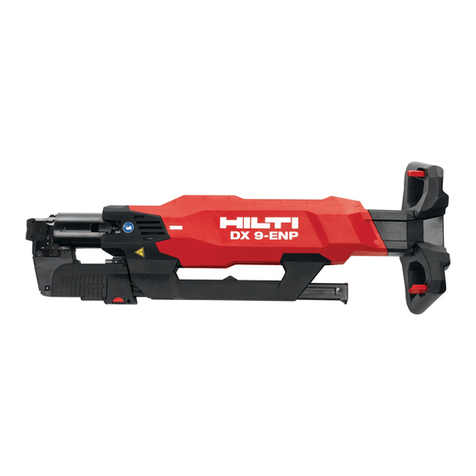
Hilti
Hilti DX 9-ENP Original operating instructions
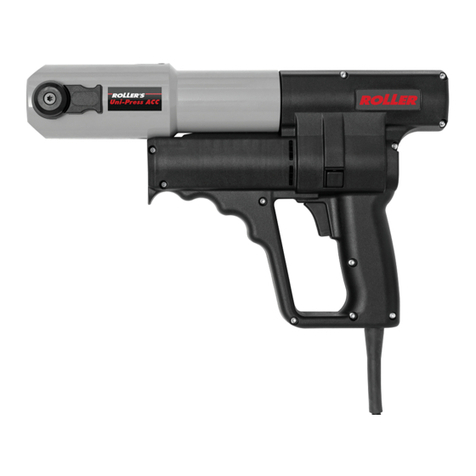
Roller
Roller uni-press instruction manual
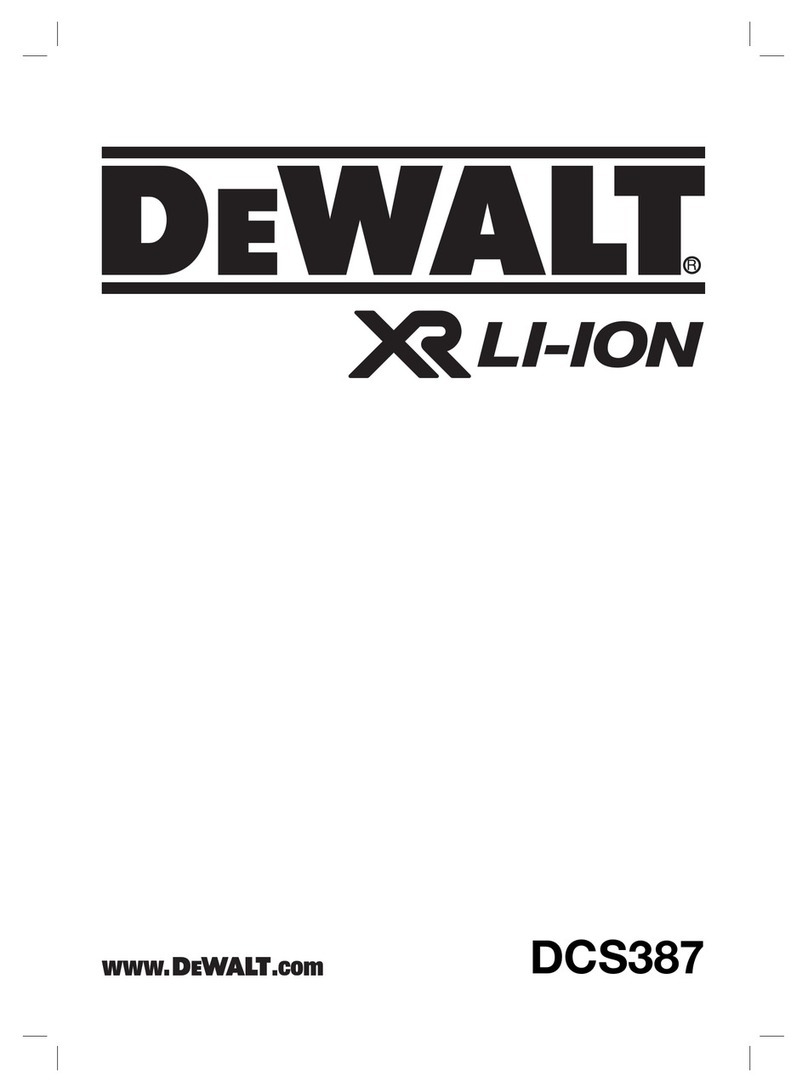
DeWalt
DeWalt DCS387 Original instructions
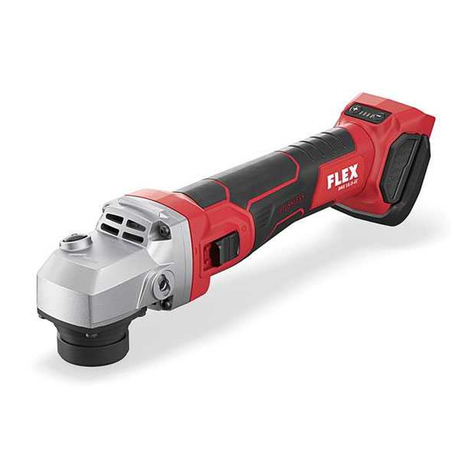
Flex
Flex TRINOXFLEX BME 18.0-EC + LK 152 Original operating instructions
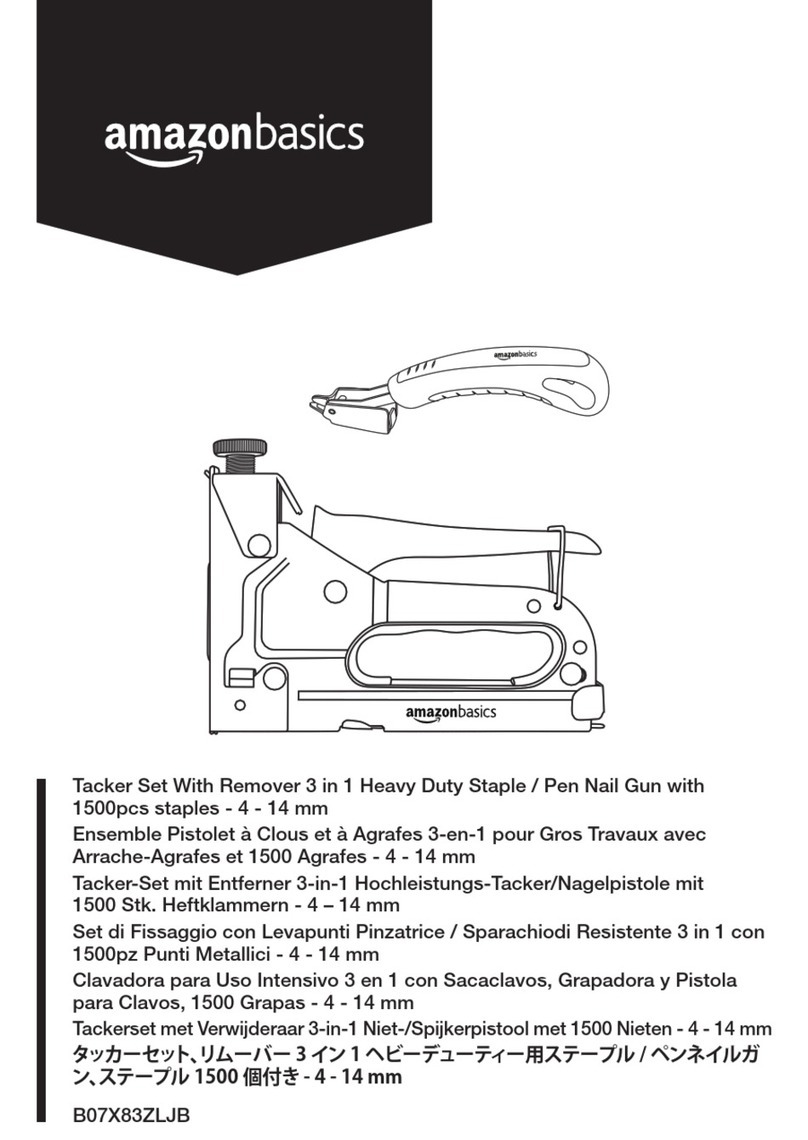
AmazonBasics
AmazonBasics B07X83ZLJB manual

Galax Pro
Galax Pro 78221 Owner's manual & safety instructions
